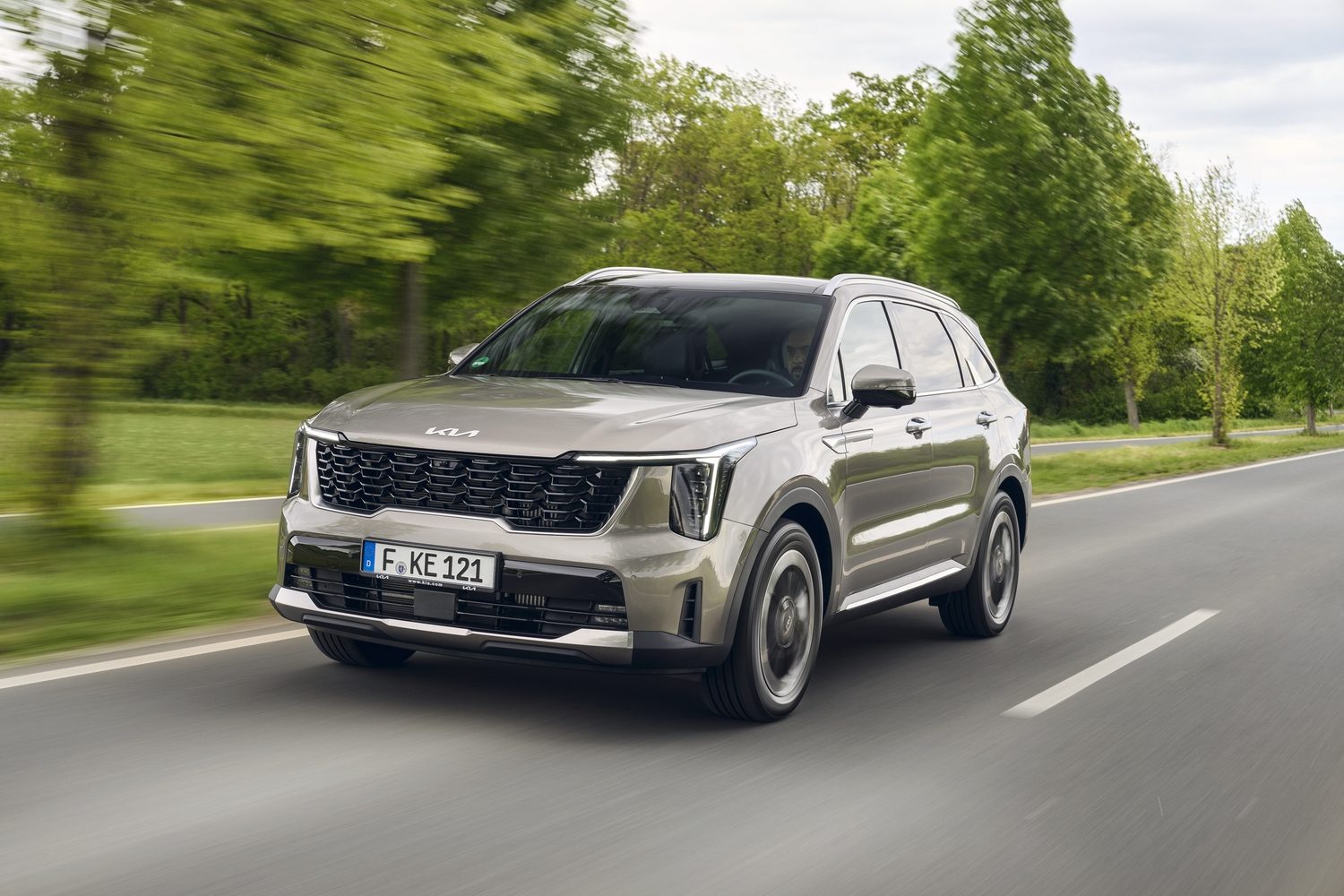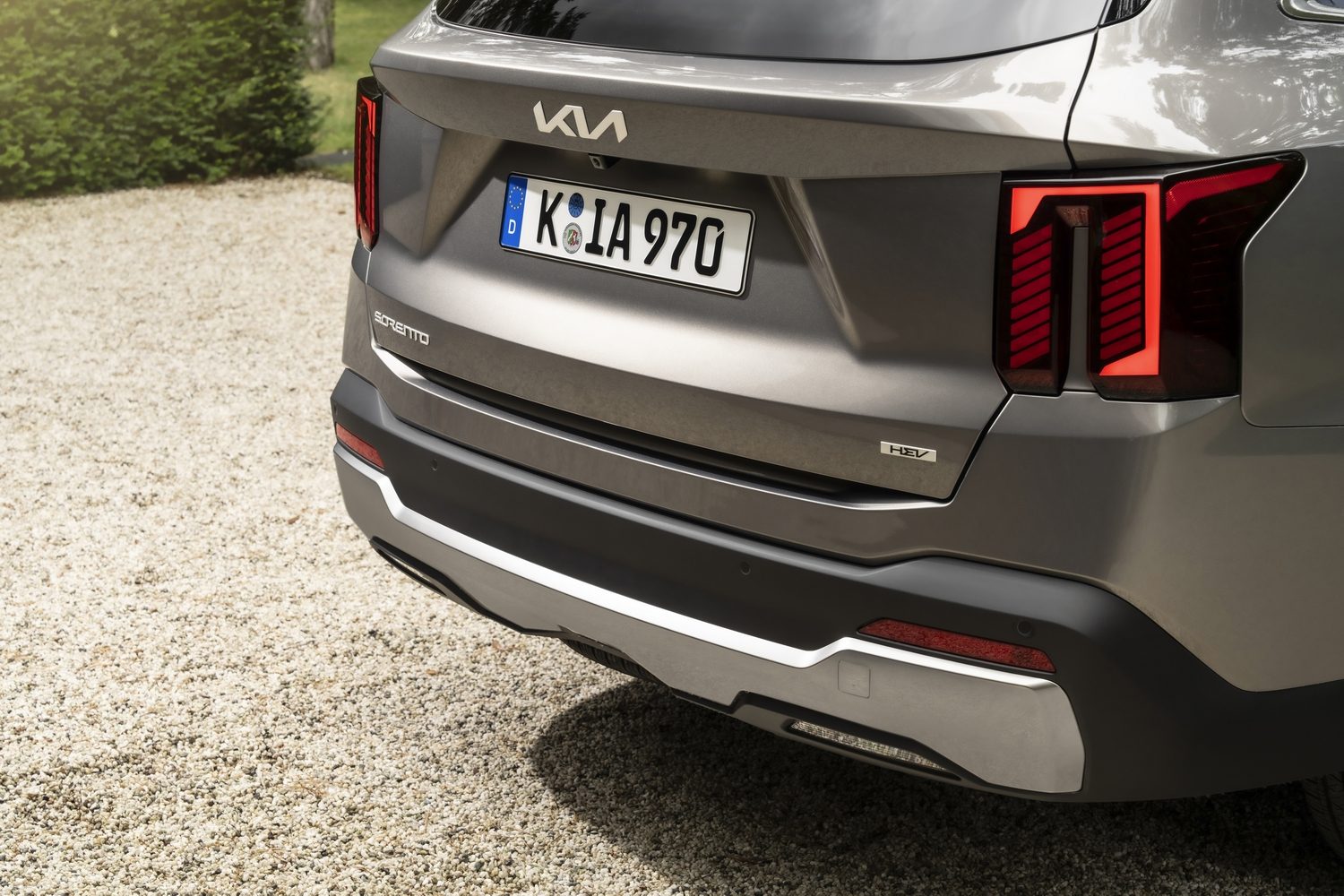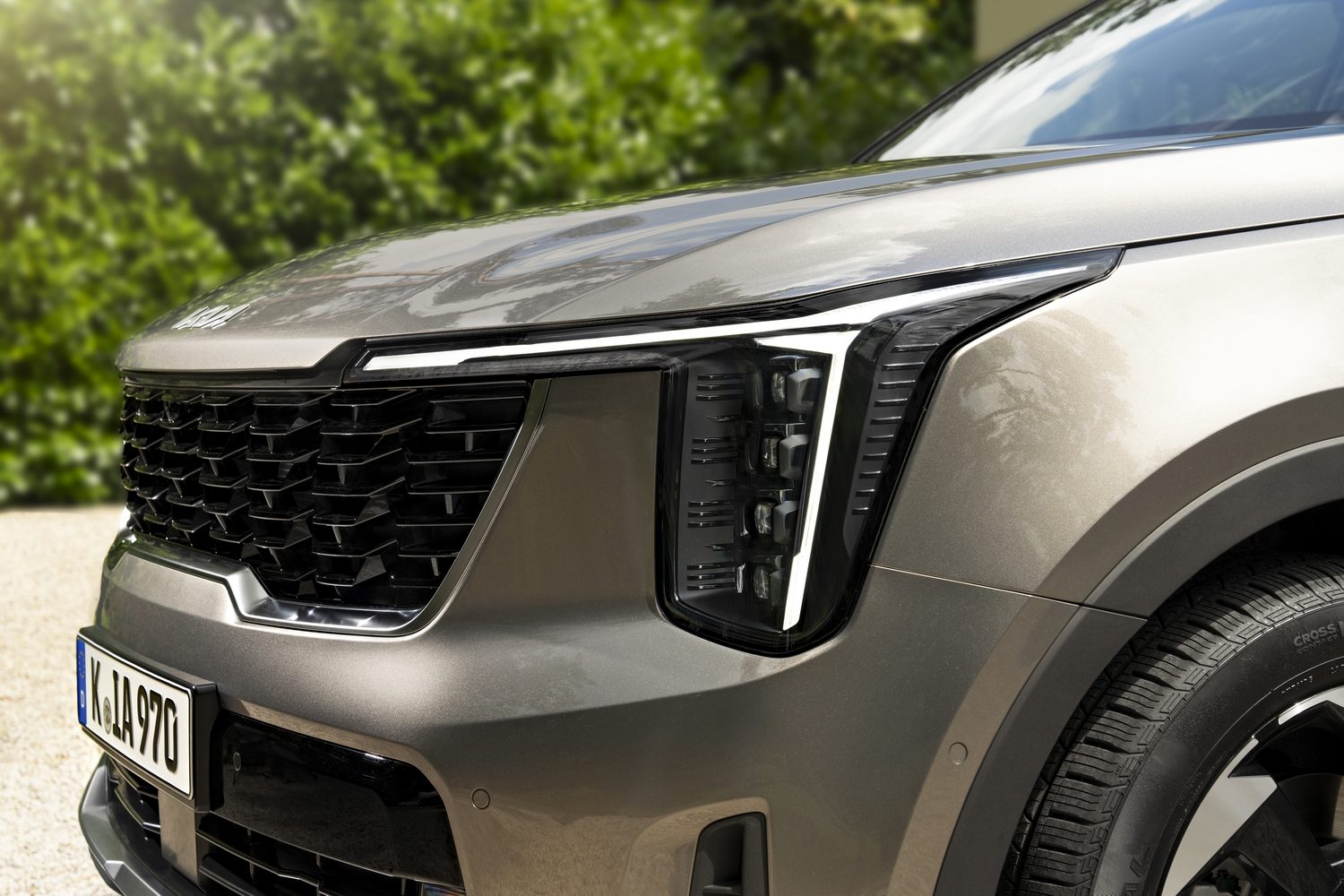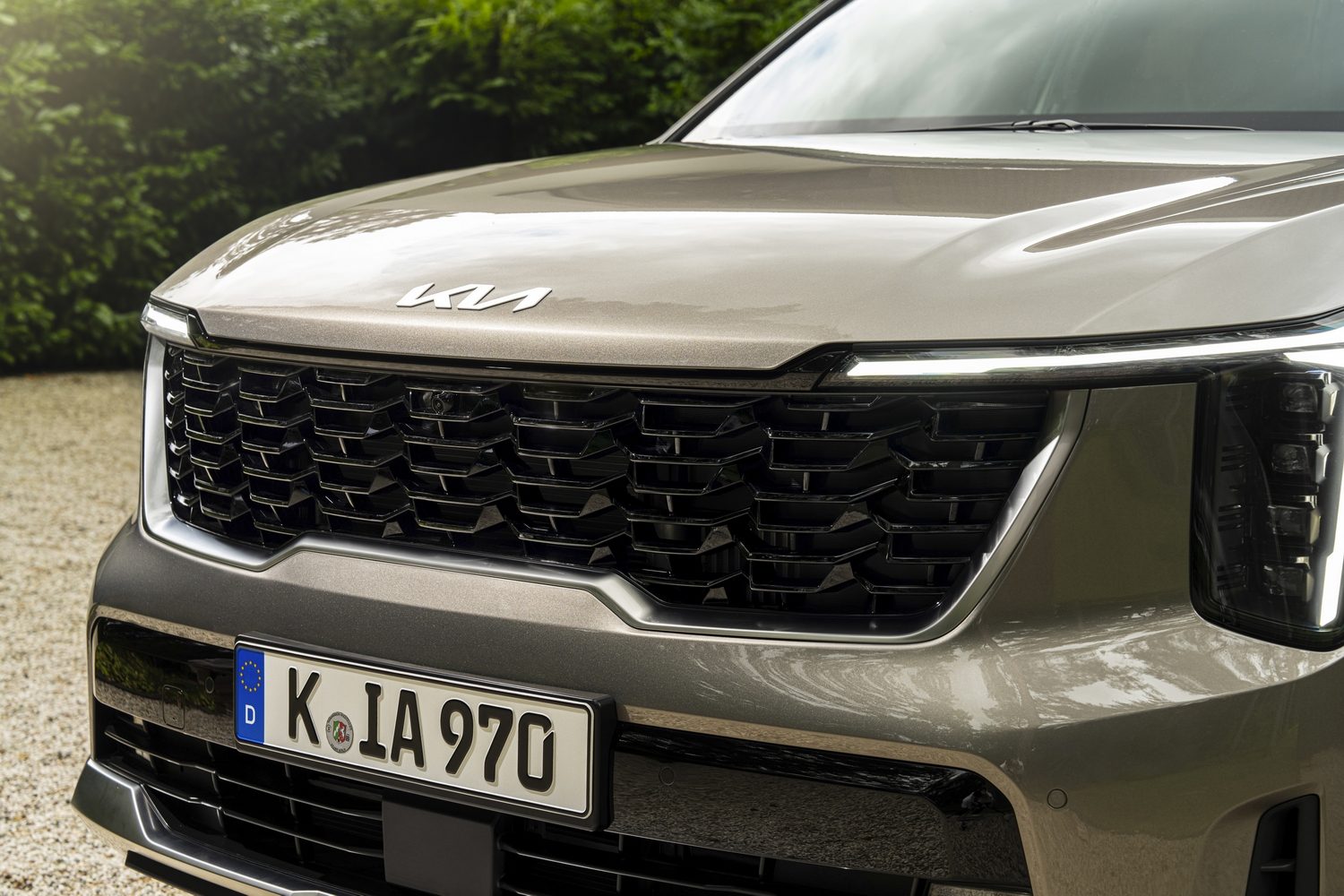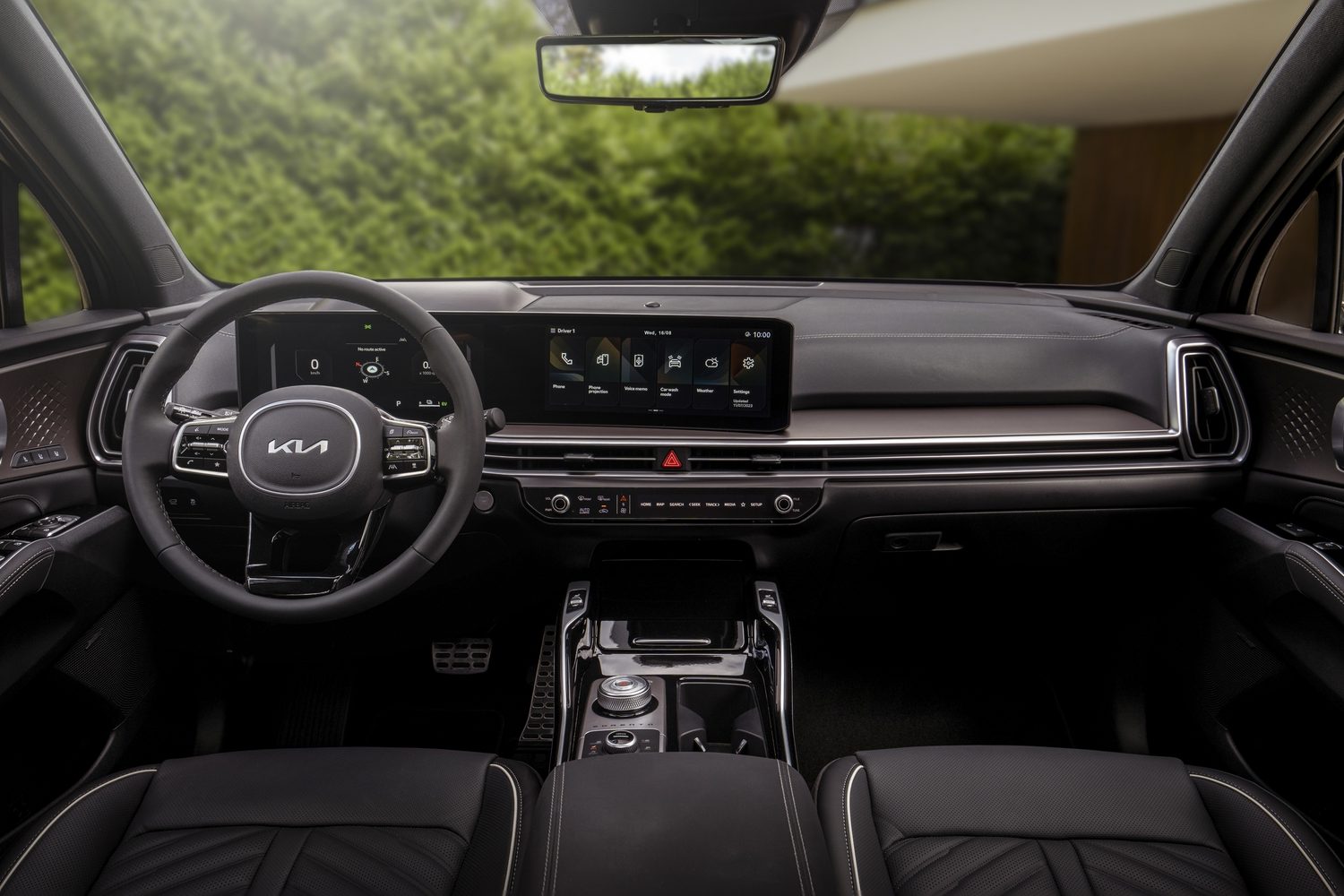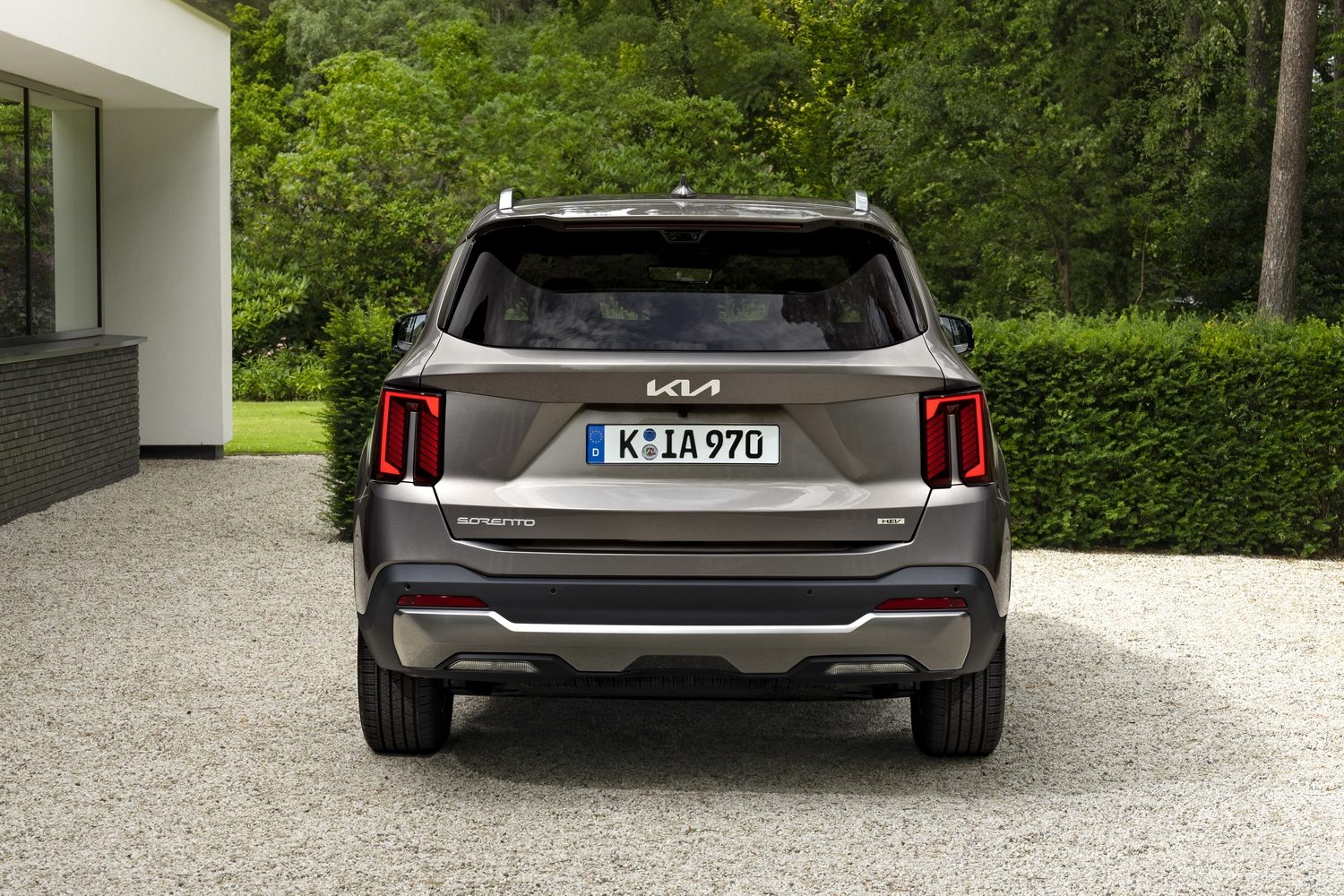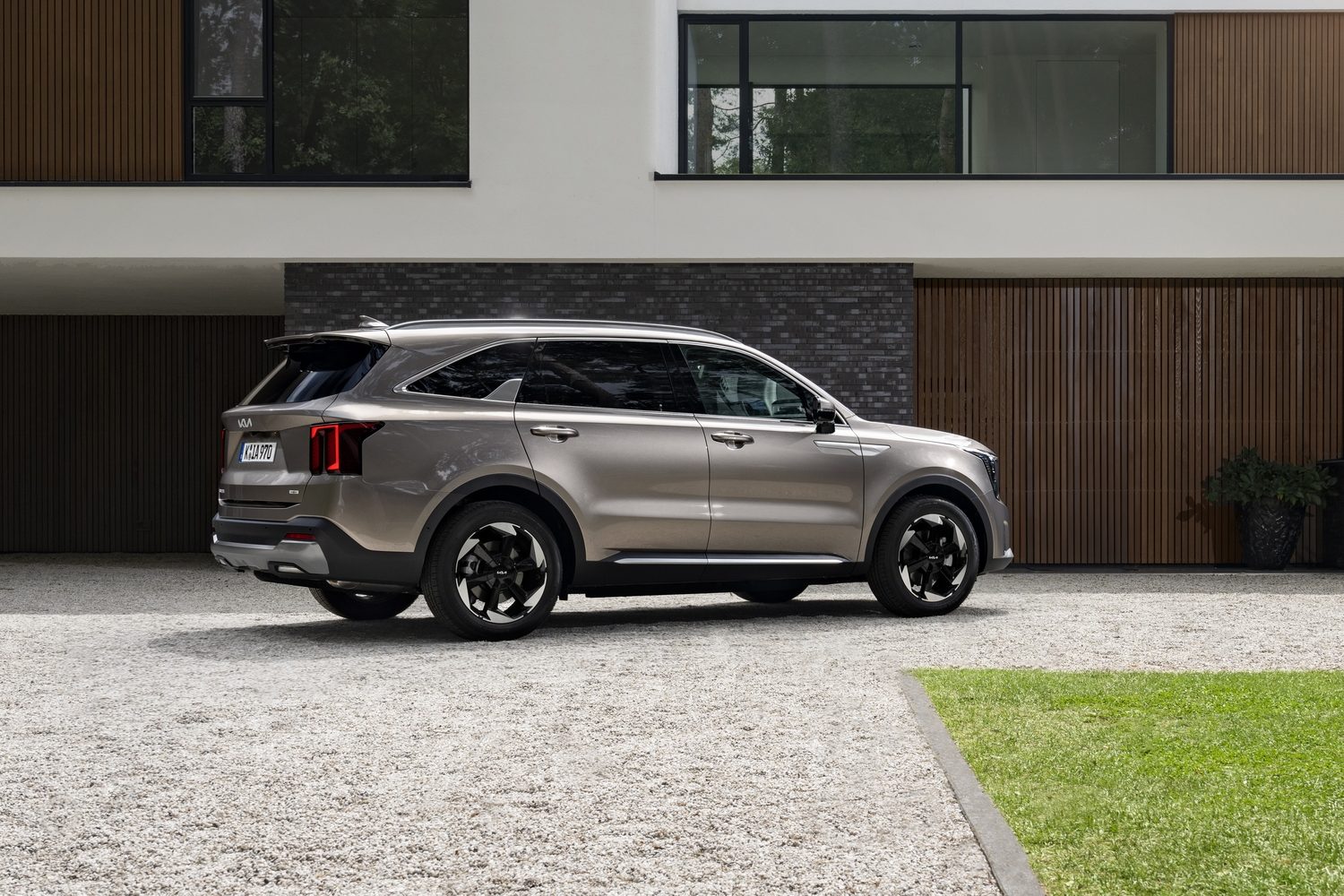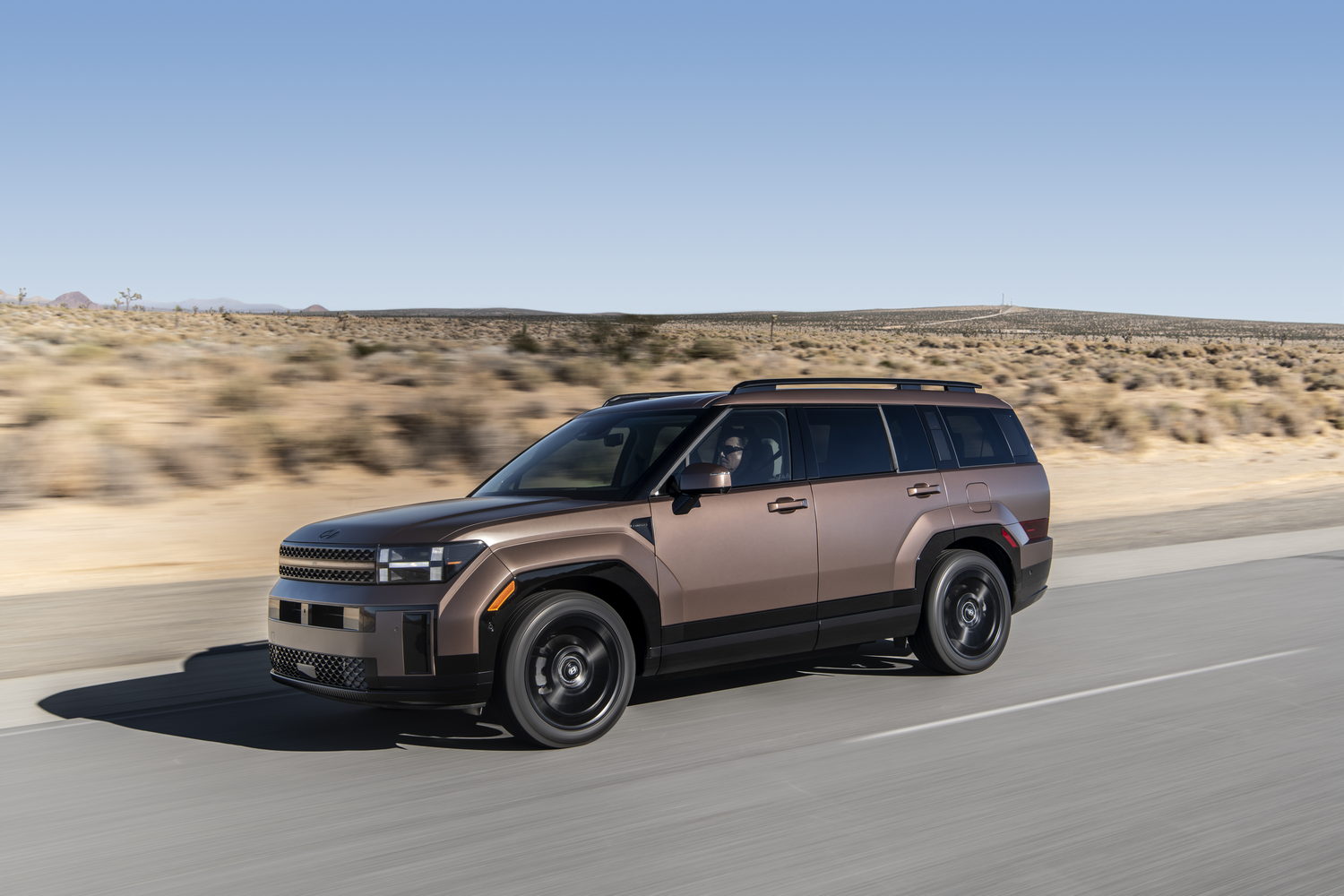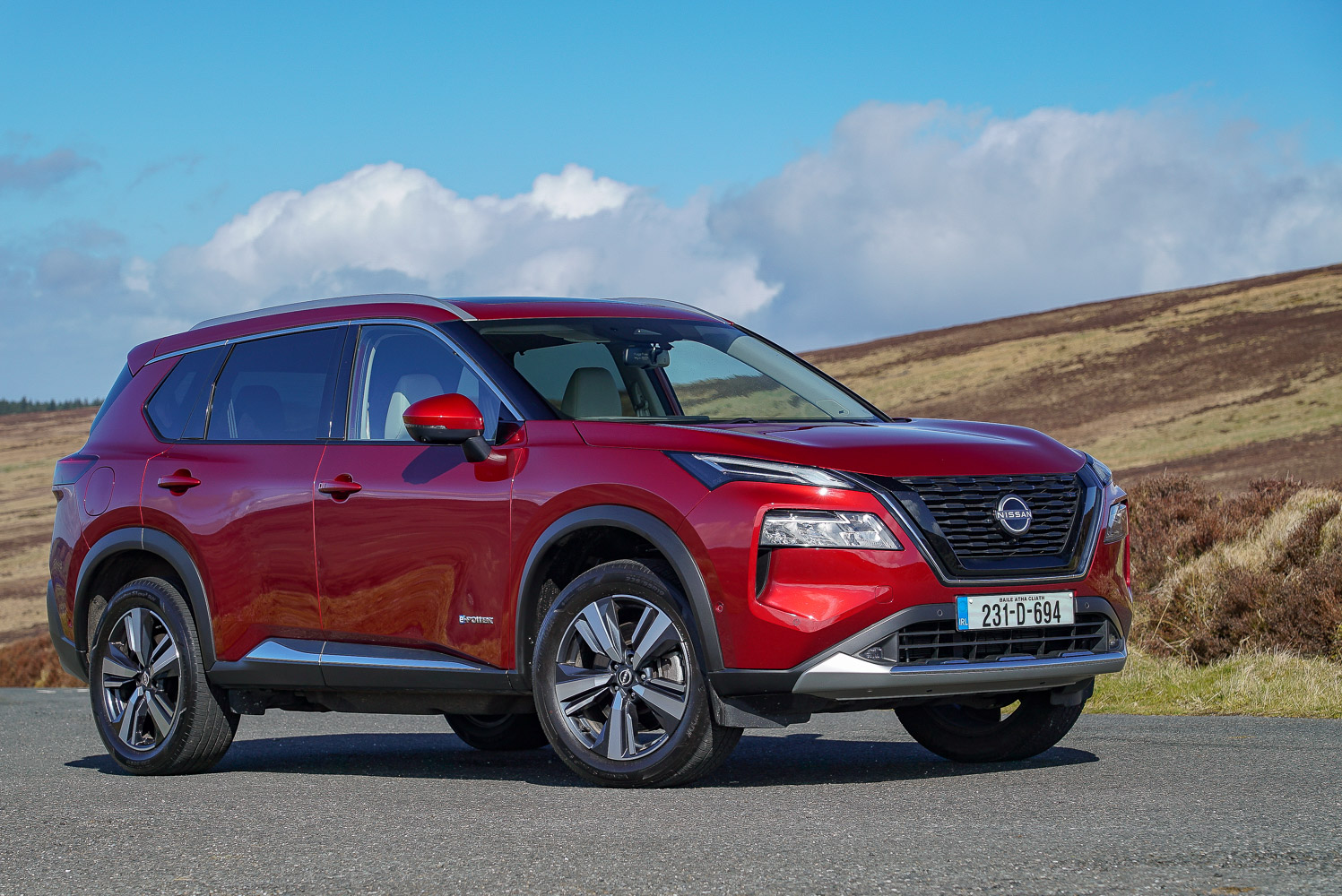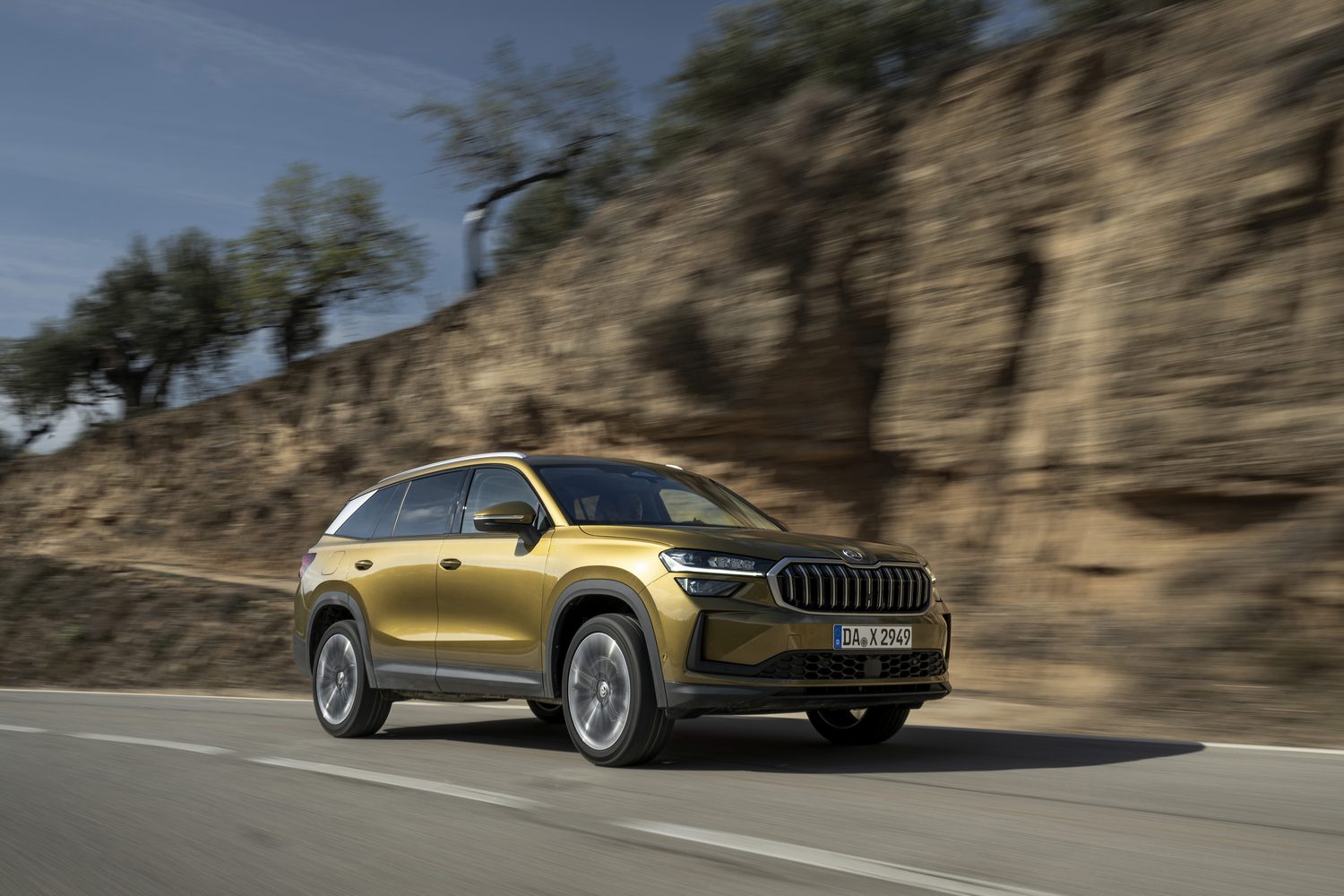With the arrival of a new Hyundai Santa Fe and a new Skoda Kodiaq, it was high time Kia updated its contender in the mainstream large SUV market. The Sorento has already charmed with its value and practicality, but Kia has clearly sensed the need to do more with this new model.
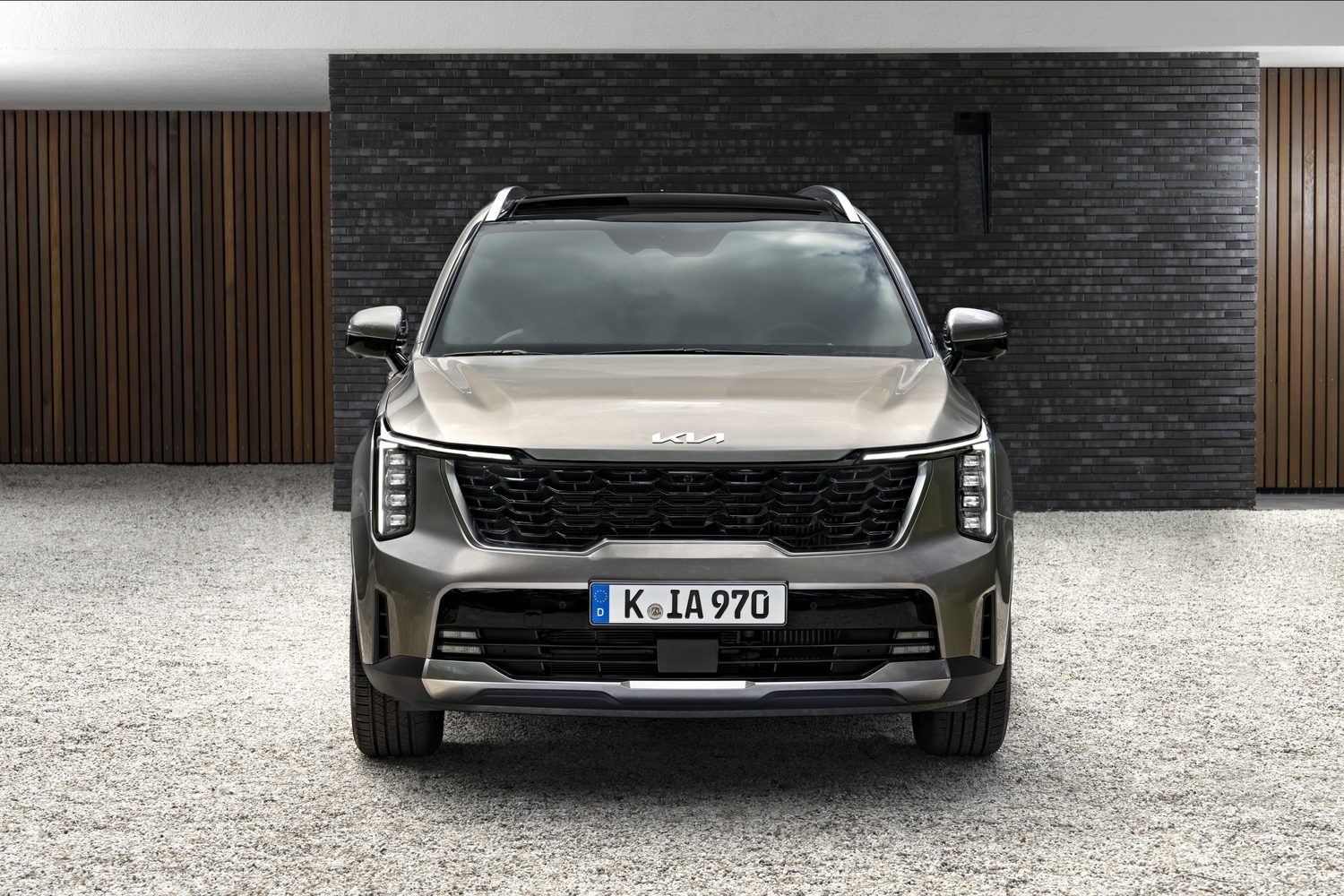
Hence the fresh styling inherited from the Kia EV9, more focus on technology in the cabin and the continuing desire to buck the trend with a choice of diesel and hybrid powertrains. Although we were in the UK to sample it, and there are some strange differences between the British and Irish specifications, this is our first chance to drive the updated Sorento.
What does the new Kia Sorento look like?
The EV9’s influence is spreading throughout the Kia range, to the point where even the new Picanto has some styling cues from the massive electric SUV. The changes sit a little more easily on the larger Sorento, but they are also more subtle, with some narrow lights and tweaked bumpers representing the major differences.
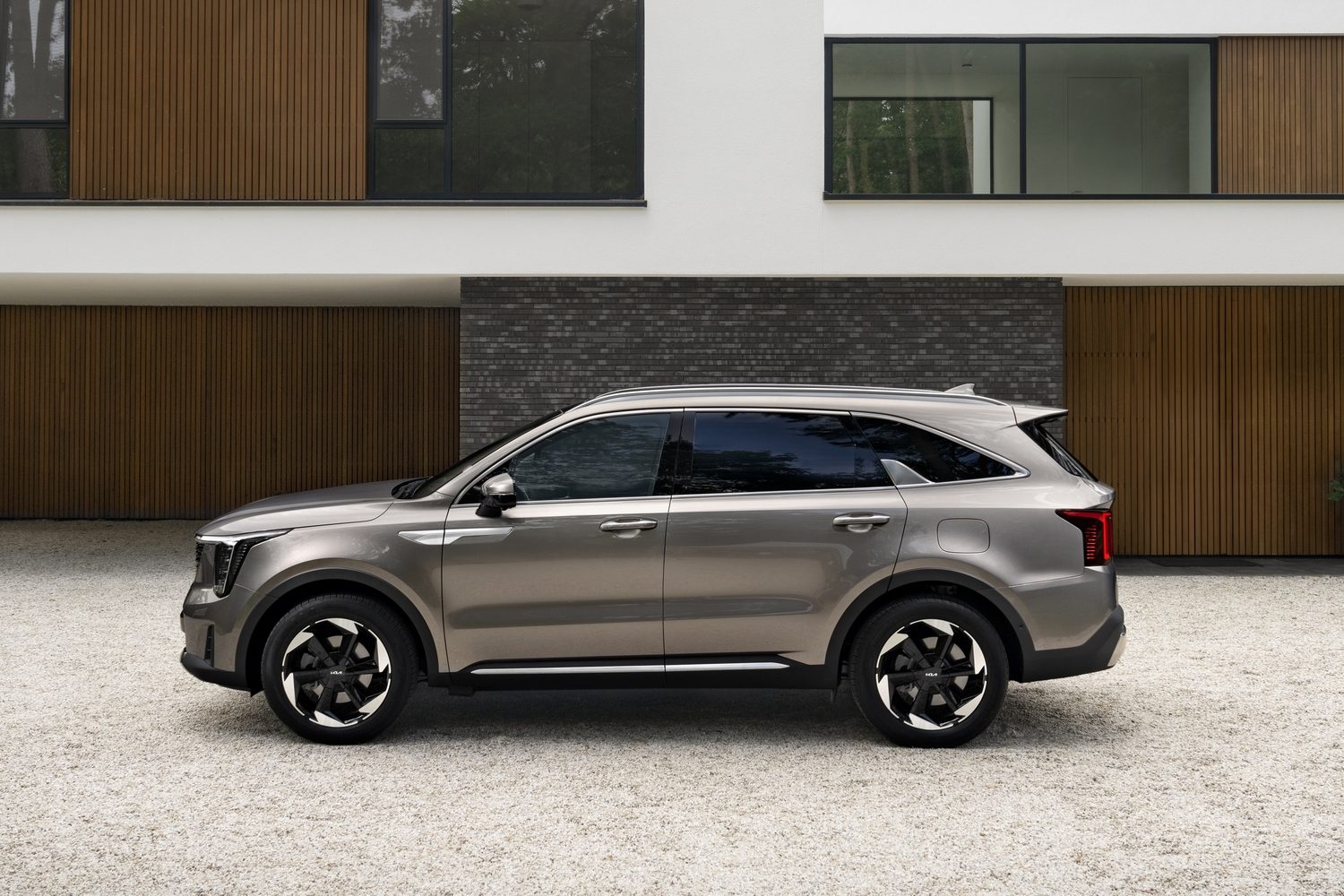
There’s no doubt the changes have made the Sorento feel more modern, but it’s still a very bulky and chunky thing, despite Kia’s efforts to streamline it slightly with a new bonnet design and a different rear spoiler. But though it is not a sporty car in any way, Kia is pushing its premium credentials with neat touches such as those slim LED lights and a wiper that’s hidden in the spoiler.
A look inside the updated Kia Sorento
The biggest tech addition to the Sorento is the touchscreen infotainment system, which now lives in a wide curved display spanning almost half the dashboard. The 12.3-inch touchscreen sits alongside the digital instrument cluster creating an almost seamless band of colour across the dash, and there’s a handy shelf underneath against which you can brace your hand to make it easier to use on the move.
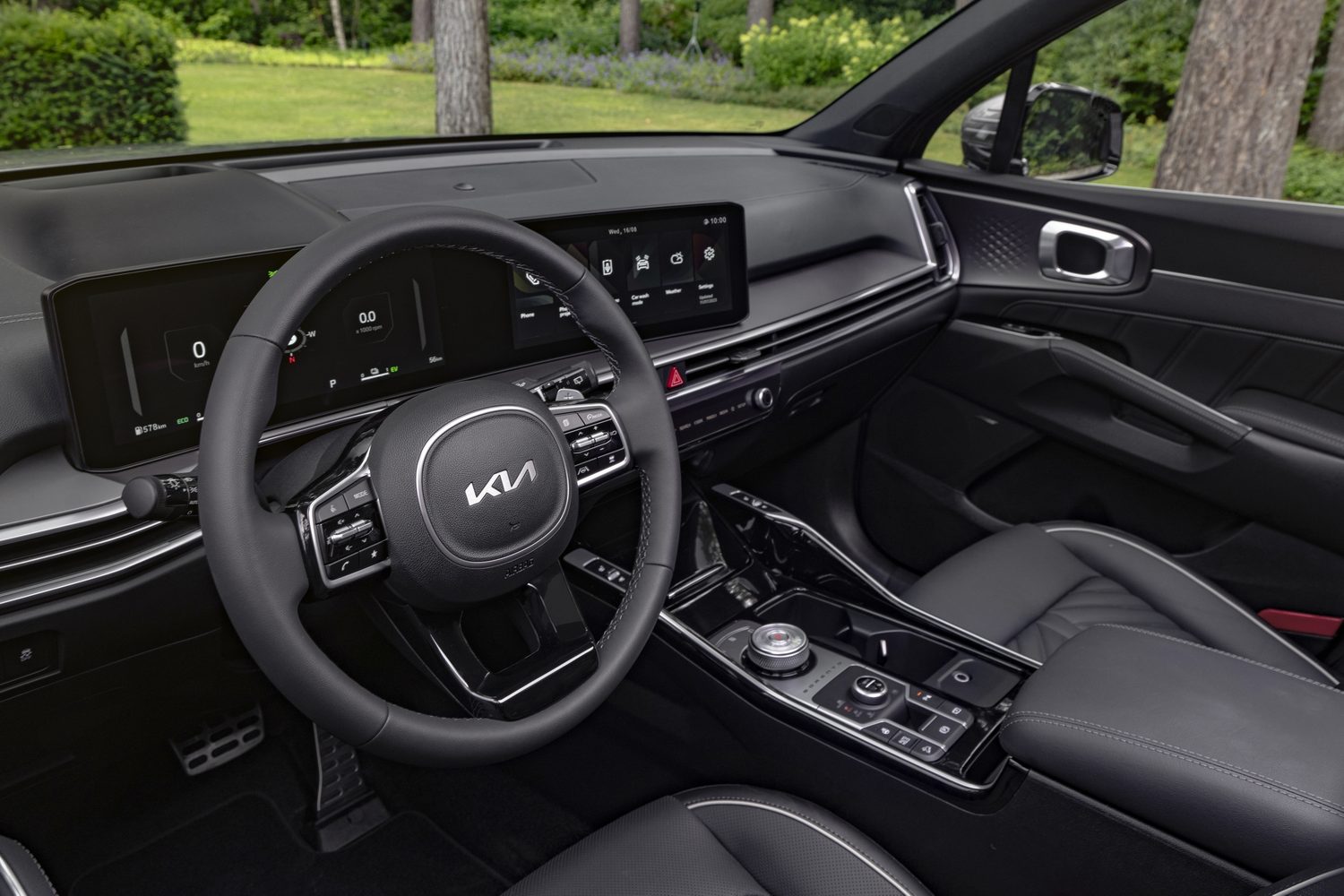
And Kia has fiddled with the dash slightly, too, adding new switchgear for the climate control and audio, although the centre console remains unchanged. All that means there are plenty of buttons, and though working them all out will take a little time, they make life easier when you’re driving, and save you having to plough through interminable touchscreen menus. Other carmakers, take note.
Generally, though, the Sorento’s cabin hasn’t changed all that much, and it still has the same chunky look to it as before. It feels nice and chunky, too, with lots of solid materials and robust controls, as well as some newfound eco-friendly materials. There’s more recycled plastic in there than before, and there’s some bio leather as well.
And just as the image is unchanged, the amount of space is unchanged. The plug-in Sorento has fractionally less room than the diesel, but you’d be hard pushed to notice. The cabin space is essentially identical, so there’s the same huge amount of space in the front and middle rows and the third row is still suitable for human occupation, unlike some seven-seat SUVs we could mention.
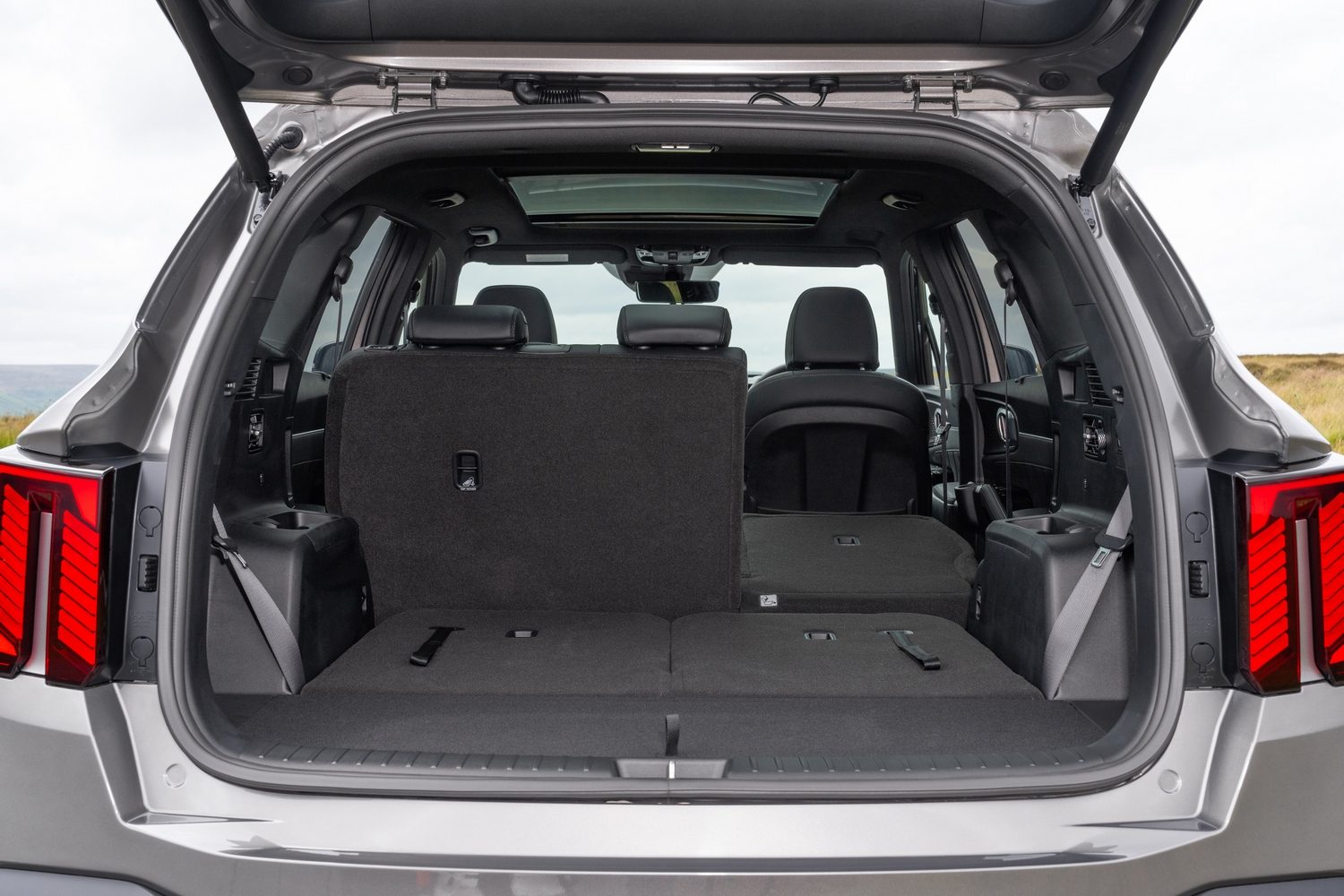
But with 175 litres of space behind the third row, boot space is down by two litres compared with the diesel, and when you fold the back seats down, that difference doubles to four litres. But an 809-litre luggage bay is still enormous in a five-seat configuration, and the 1,988-litre space you get when you fold the middle row down is little short of cavernous.
The Kia Sorento’s on-board technology
The touchscreen is still among the highlights of the Sorento’s cabin, and it’s certainly the most important new addition. Bigger and better than before, it’s a clear and easy-to-use system that keeps things relatively simple. Some might prefer flashier graphics, but the Kia system is intuitive, logical and clear, which makes it easier to use when you’re driving.
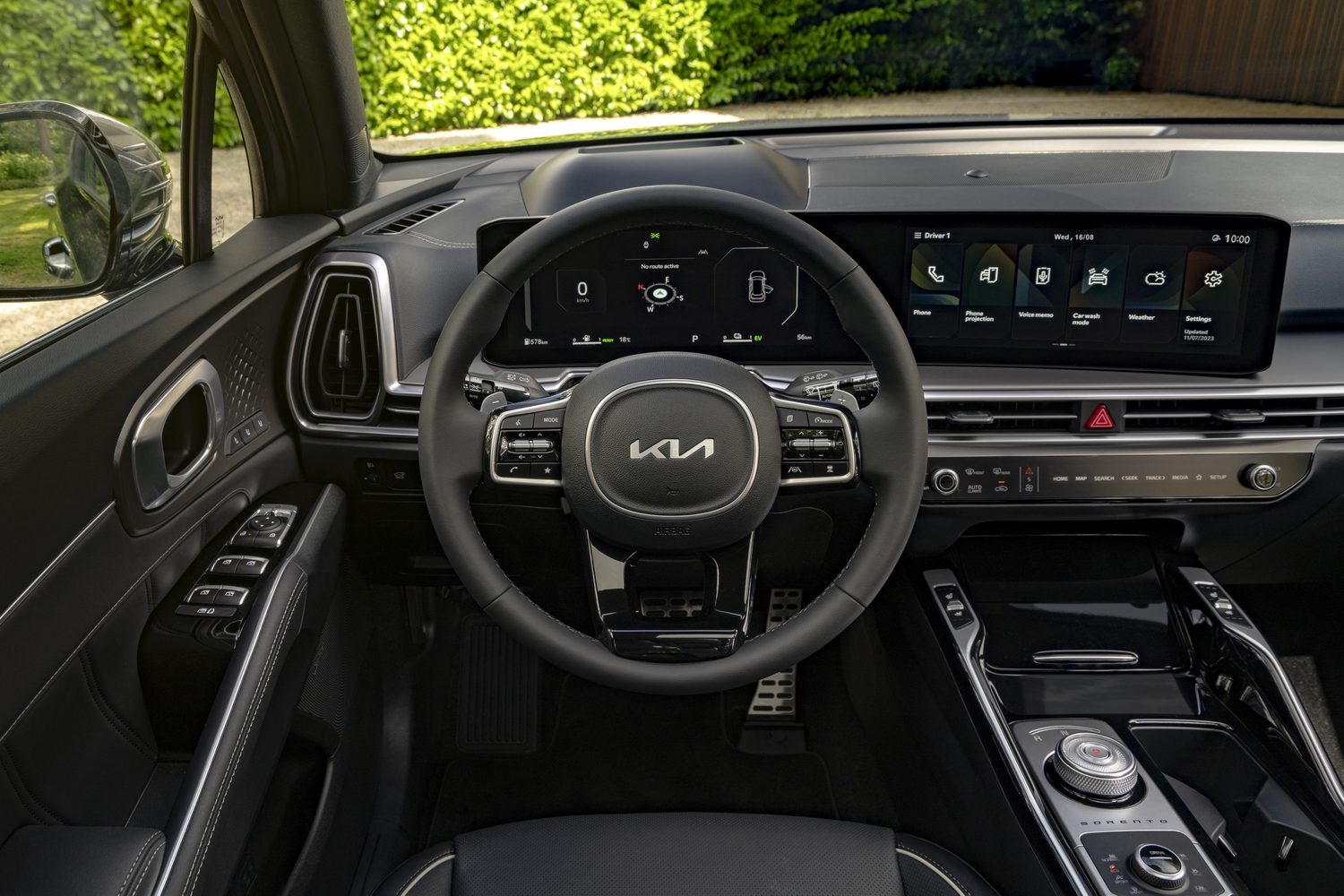
And it still comes with all the stuff you need. There’s a reversing camera in there, navigation and the option to use the Apple CarPlay and Android Auto smartphone integration systems, which render your thoughts on the graphics irrelevant. The long and short of it is it’s a very functional, user-friendly system that won’t let you down.
And the digital instrument cluster is arguably even better. Like the touchscreen, it’s clear without being a graphical marvel, but it has some great features. Not only is there a degree of configurability, but it also comes with a blind-spot camera that starts whenever you indicate and offers a view down the car’s flanks to help you spot any unseen vehicles, pedestrians or cyclists in the hard-to-see areas over your shoulders.
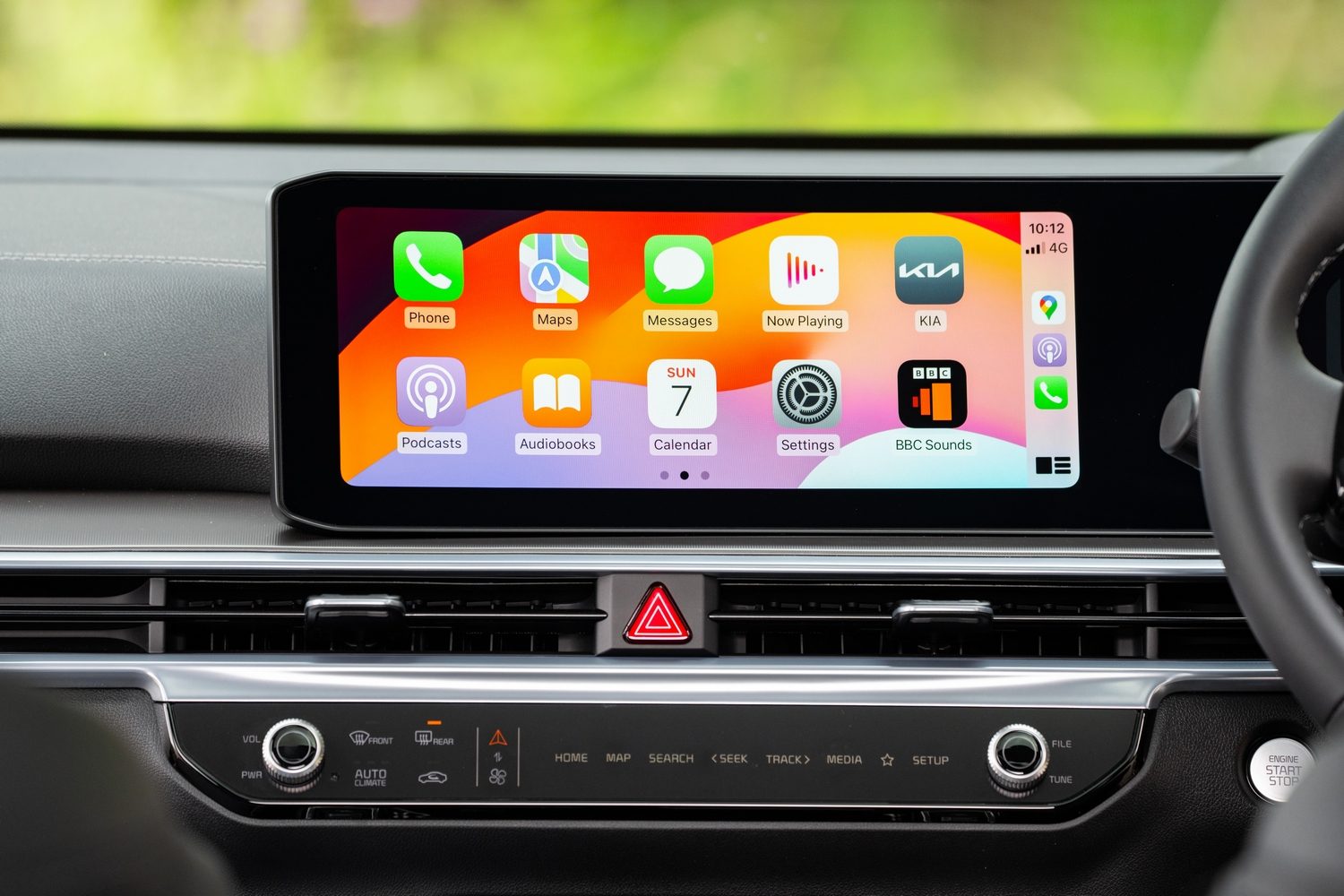
How efficient is the Kia Sorento PHEV?
While towing and long distances are the forte of the diesel Sorento, this plug-in hybrid version has a greater focus on efficiency around town and off-road thanks to its all-wheel drive. But it is also the more powerful of the two options. As before, it gets a 1.6-litre petrol engine and an electric motor, which combine to produce 265hp in Irish-specification cars. For reasons unknown, our UK-specification test car only got 251hp.
Either way, this is the quickest Sorento on paper, but it doesn’t feel as punchy as the meaty diesel engine, whatever the figures may suggest. And it’s less refined, because that 1.6-litre engine drones away whenever it’s running, leaving you in no doubt whether you’re running on petrol or electricity. In fairness, the six-speed automatic gearbox must take some of the blame, holding on to gears for a bit too long at times, especially under acceleration, and occasionally picking too low a gear for the situation.
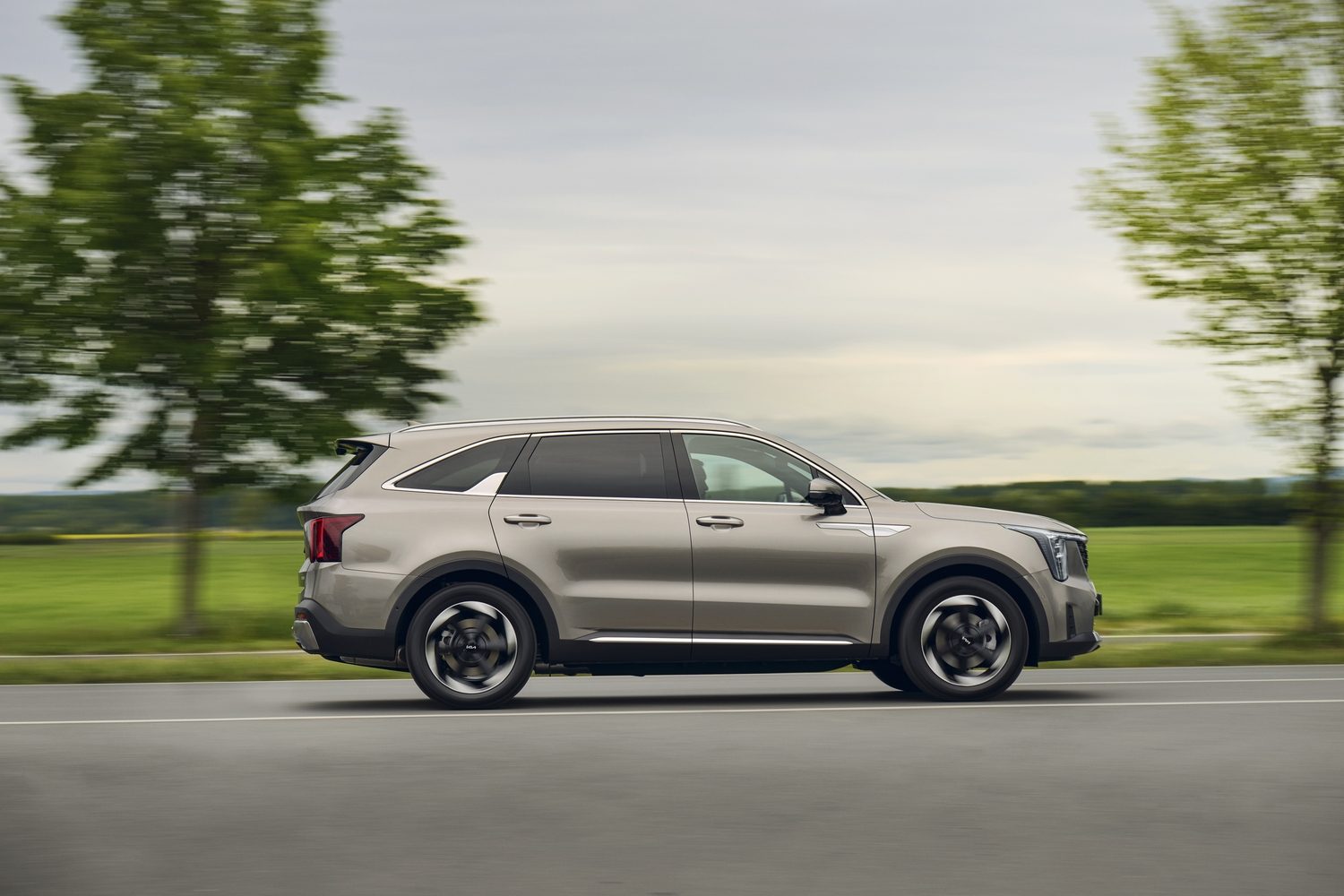
But no matter, because you can run on electricity a lot of the time instead. There’s a 13.8kWh battery that powers the electric motor, though that isn’t especially big. And with all that drag and weight, it equates to a maximum zero-emission range of 55km, which isn’t all that impressive. But it should be enough for plenty of owners’ commutes, shopping trips and school runs, which is ideal for a plug-in hybrid, particularly if you can charge at home.
Do that regularly, and you could well find yourself burning comparatively little petrol at all, and possibly even getting close to the official fuel consumption of less than two litres of unleaded every 100km. That will undoubtedly appeal to some, but perhaps the more important thing is the emissions, which are well under the 50g/km limit for higher rates of motor tax and low enough to keep company car tax in check as well.
Driving the Kia Sorento PHEV
The Sorento is very much set up for comfort, as opposed to handling, so it’s quite softly sprung. In the case of the diesel, that makes it comfortable, soaking up the bumps very tidily, but the plug-in hybrid seems a fraction more brittle, riding the potholes more heavily and with a little less compliance. Perhaps it’s the weight that does it - the plug-in hybrid weighs about 200kg more than the diesel - but it’s less comfortable around town, as well, where the bumps have a greater impact. It settles down quickly, though, and it rides well on the motorway.
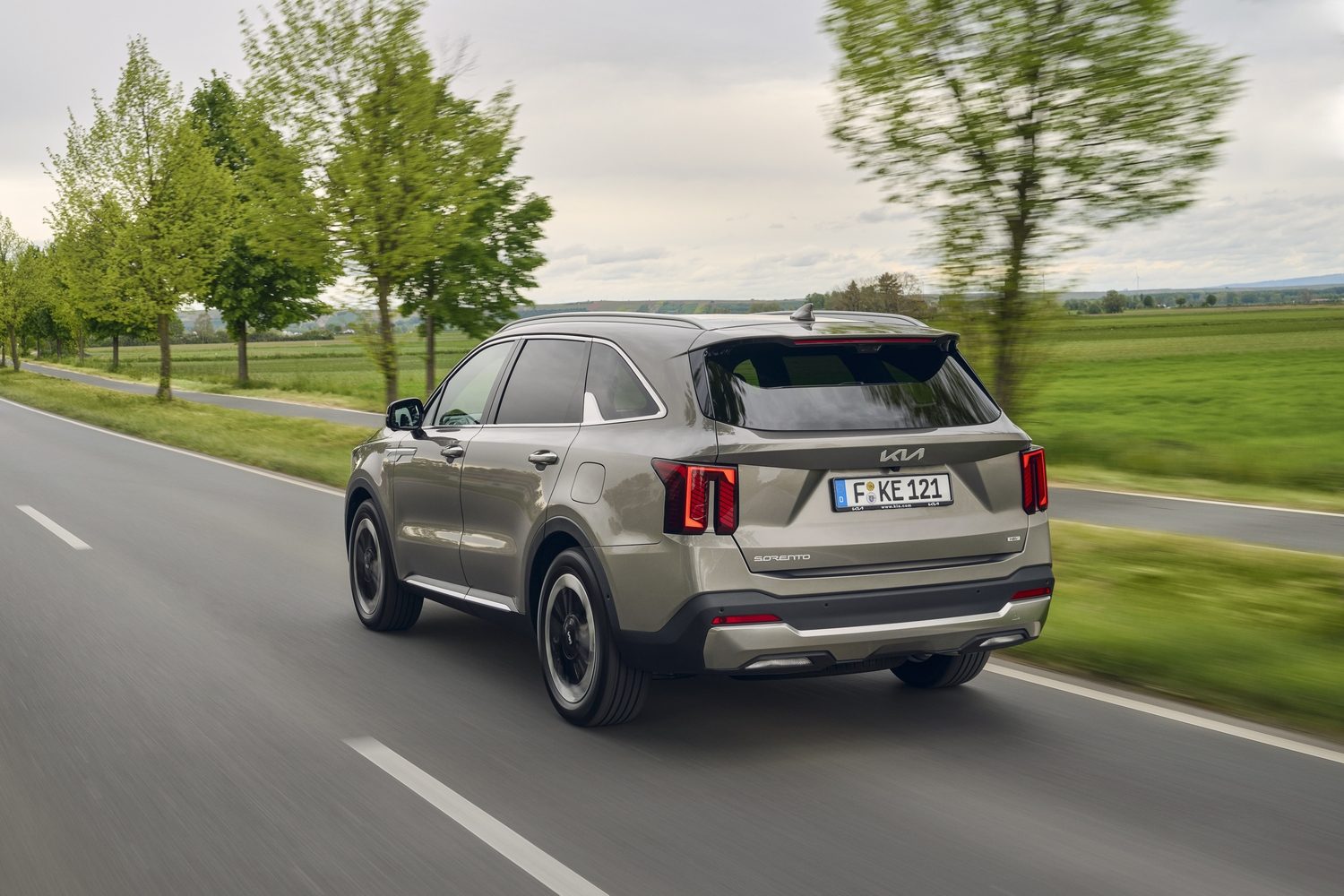
But the hybrid system means the motorway won’t really be this car’s forte, and the attempts to make it ride well have left issues when it comes to handling. It steers quite nicely, but there’s a fair bit of lean in corners as that bulky bodywork swings around on the springs, and that makes it less enjoyable to drive than some smaller, lighter rivals.
In urban areas, meanwhile, the car is easy enough to drive, but it’s still a big old beast and some might prefer a car with a bit less bulk. Particularly if you’re trying to squeeze through a narrow gap. That said, the car is more refined than its engine, so cabin noise isn’t a great issue when you’re running on electrical power, and though the six-speed gearbox doesn’t cover itself in glory when you put your foot down, it generally changes gear quickly enough.
The other advantage of the plug-in powertrain is that it’s the sole all-wheel-drive option in the Irish Sorento range (the diesel gets all-wheel drive as standard in the UK, but not in Ireland) and it has reasonable off-road credentials. Yes, it’s big and heavy, but there’s a good amount of ground clearance and there’s a drive mode selector with terrain settings that will help you keep moving on the rough stuff.
How safe is the Kia Sorento?
As the bodywork changes are aesthetic, rather than structural, the new-look Sorento inherits its predecessor’s five-star Euro NCAP rating. The old car scored solidly in every area, from child occupant protection to safety assistance technology, and the new model is equally capable, if not more so.
The list of driver assistance technologies available is lengthy, but it includes a lot of the usual stuff such as lane departure systems and autonomous emergency braking that can stop the car if the driver fails to respond to a hazard. A reversing camera system is included as standard, and there’s blind-spot avoidance assistance as described above.
How many child seats can you fit in a Kia Sorento?
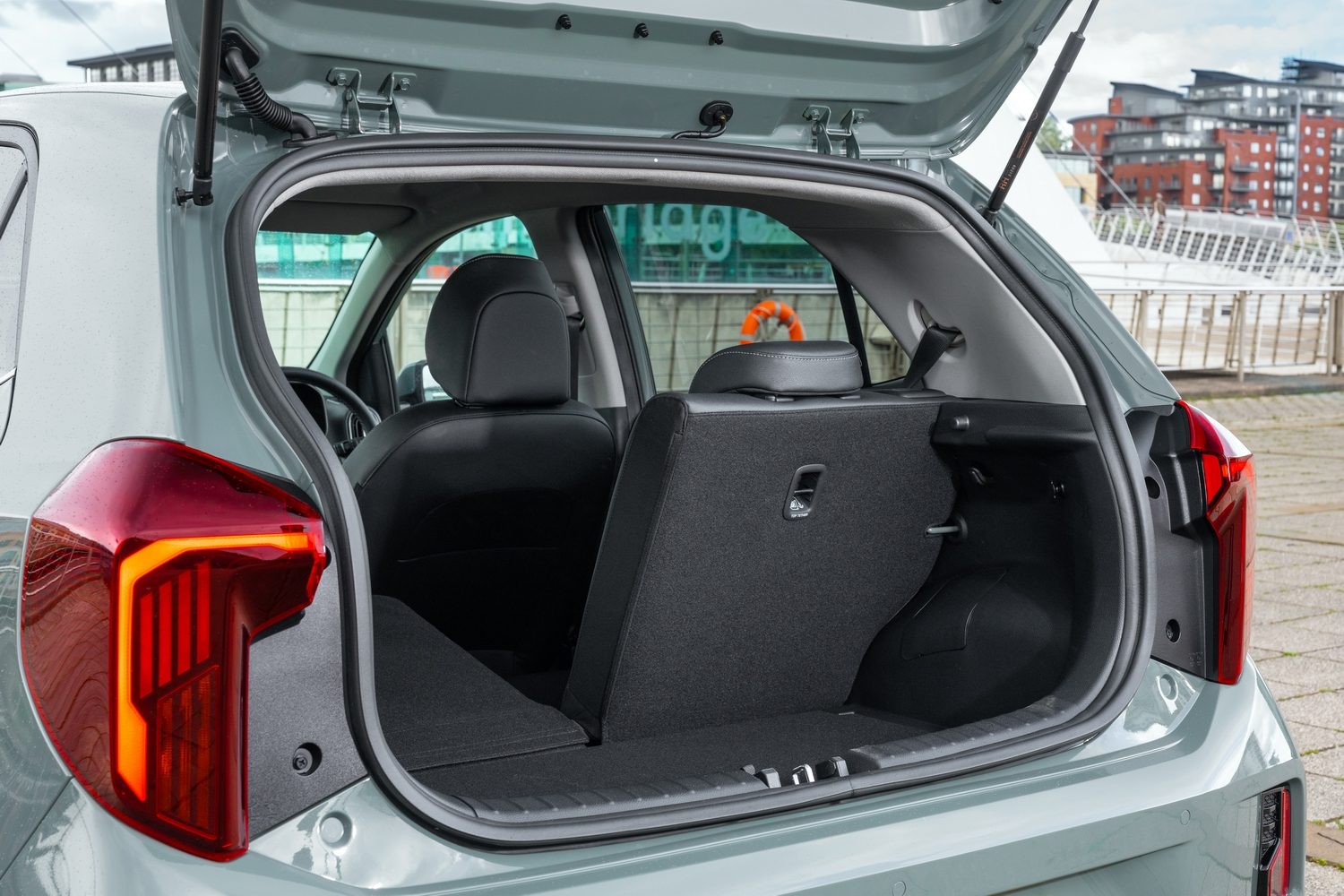
Although many ostensibly seven-seat cars only come with five seats in their plug-in hybrid forms, the Sorento still gets a full complement of seats, and Kia has decked four of them out with ISOFIX child seat mounting points. The four in question are the two rearmost seats and the outermost seats of the middle row, giving you plenty of room for even quite bulky child seats. That said, while access to the middle row is very easy, getting at the less accessible rearmost seats with a child seat in hand might be a bit tricky.
How much does the Kia Sorento cost?
There’s only one trim level available for the Sorento, no matter whether you choose the plug-in hybrid or the diesel version, but the hybrid is the more wallet-friendly of the two, albeit not by much. The €63,300 price tag is €1,000 less than that of the diesel, but the two cars get much the same level of standard equipment.
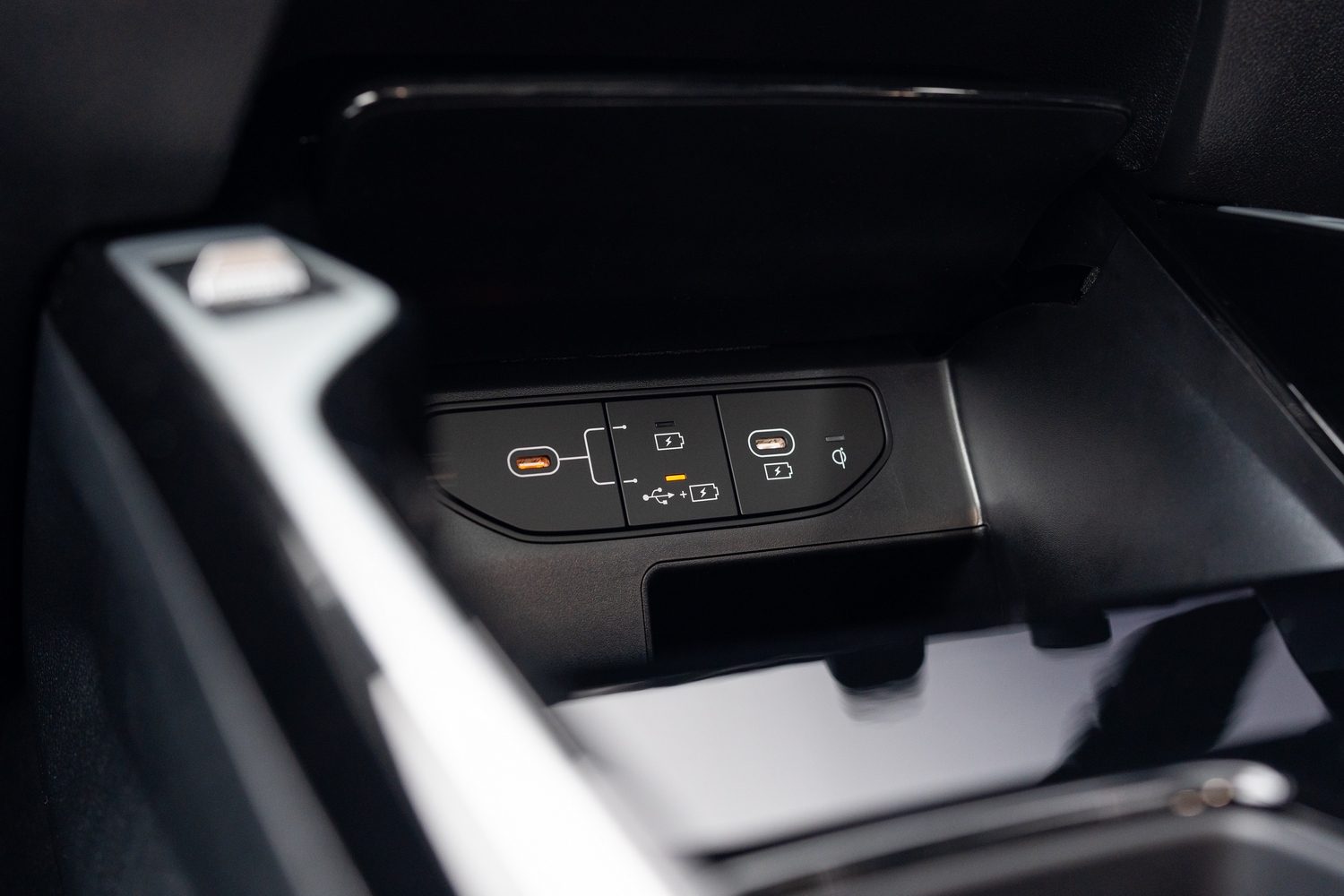
And very generous it is too. Big alloy wheels, seven seats and a panoramic sunroof are all thrown in, along with leather upholstery and a power-operated tailgate. Navigation, a reversing camera and fleets of safety systems are all in there, too. It isn’t a bad kit list considering this thing is more than €4,000 cheaper than the new Santa Fe.
The reasons you’d buy a Kia Sorento PHEV
The Kia Sorento continues to be a great-value alternative to bigger and more upmarket SUVs, as well as a strong rival for the Skoda Kodiaq and Hyundai Santa Fe. But while the plug-in hybrid makes some sense if your journeys are mostly short, the relatively small battery and comparative lack of refinement makes the diesel the more appealing of the Sorento models unless you need all-wheel drive or a low tax bracket.
Ask us anything about the Kia Sorento
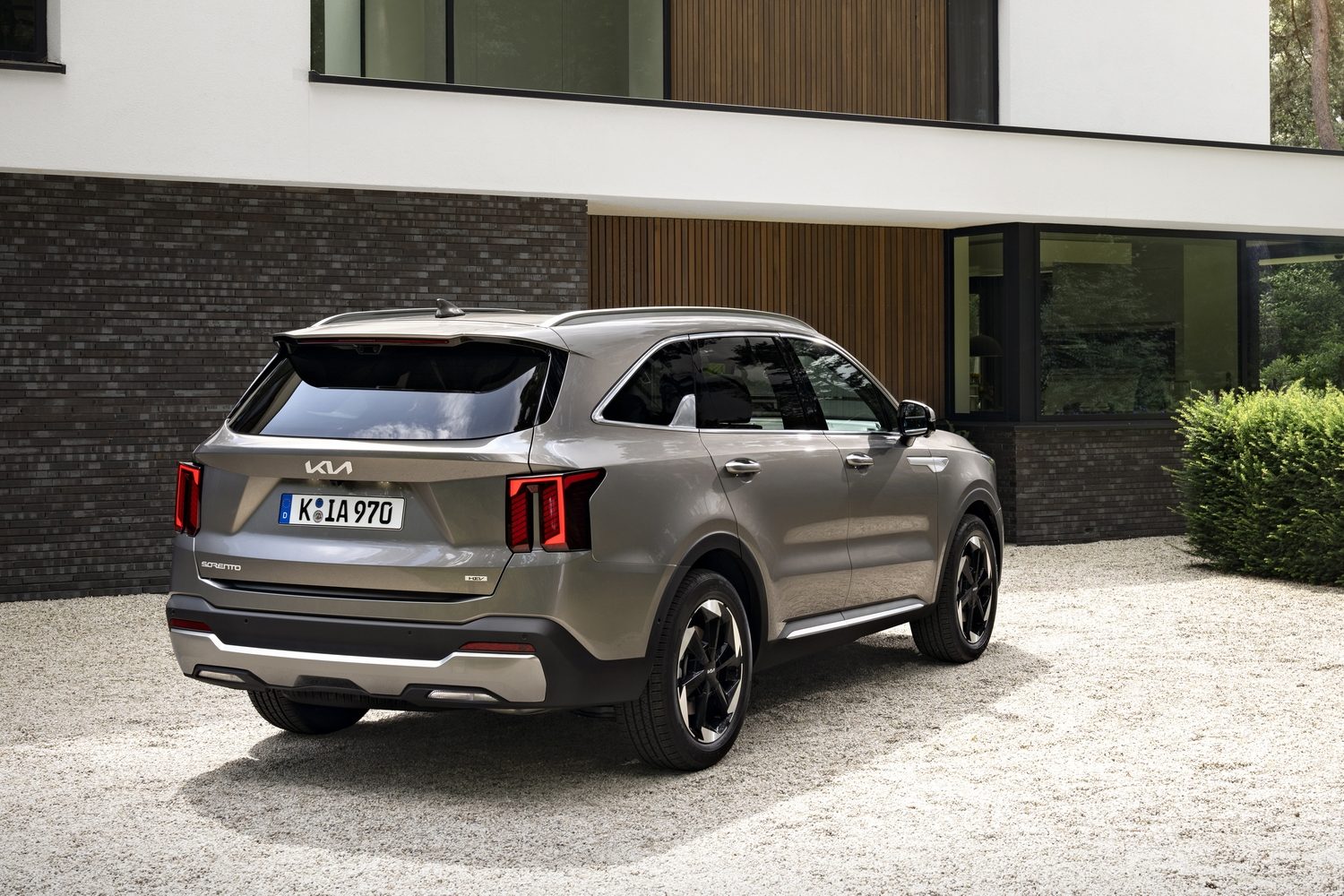
If you want to know more about the Kia Sorento PHEV, any other Sorento model or even any other car on sale in Ireland, why not take advantage of our expert advice service? Simply head to the Ask Us Anything page, where you can pick our experts’ brains for all the information you could need to make your next car-buying decision. Best of all, it’s completely free of charge.

